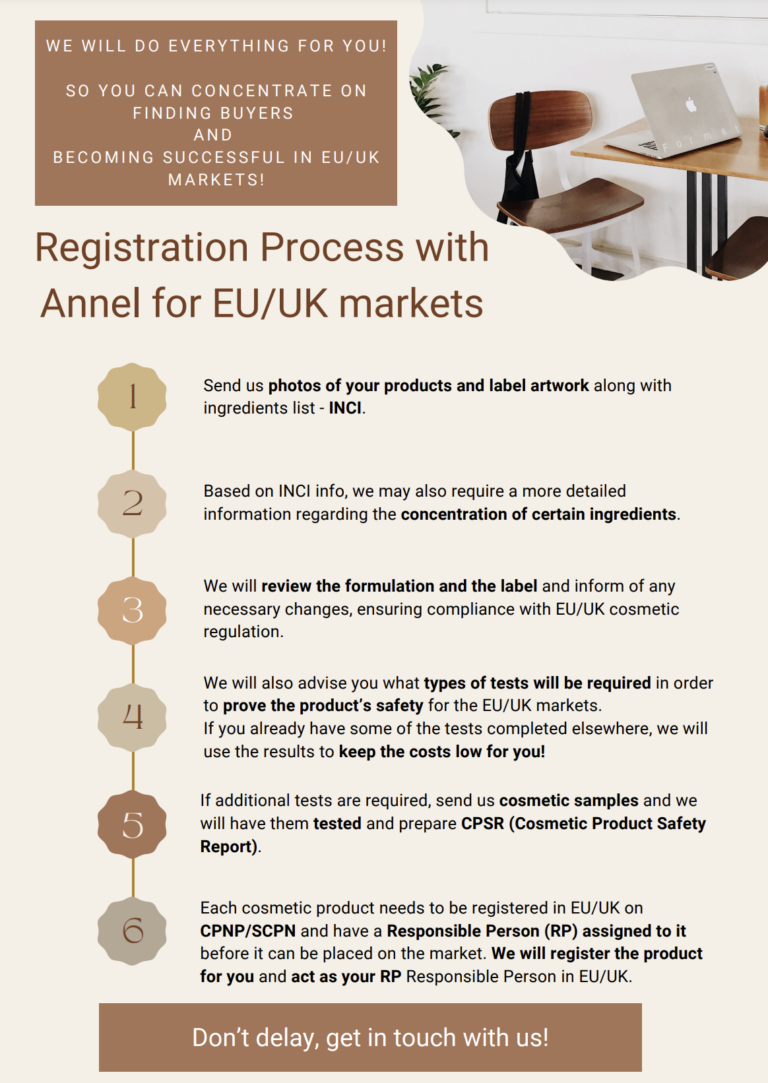Registration Process with Annel
Ingredients compliance to European Union and United Kingdom Regulations
REGULATION (EC) No 1223/2009 OF THE EUROPEAN PARLIAMENT AND OF THE COUNCIL of 30 November 2009 on cosmetic products describes what substances and ingredients may be used in cosmetics sold in EU and UK.
Having INCI of your product we are able to confirm if ingredients in your cosmetic products are compliant to EU and UK regulations.
Cosmetics testing
According to EU Cosmetics Regulation 1223/2009 cosmetic products need to be tested before they could be sold on the European or United Kingdom market. The tests are performed by laboratories that we carefully select.
At Annel, we work with a large variety of laboratories and therefore we are able to offer our clients the best prices. We know that time is money and we work efficiently, maintaining high standards of customer care, in order to meet the deadlines set by our clients.
There are various testing methods which EU and UK authorities accept. These include:
Claim substantiation
Information on product labels, leaflets and any other means of advertising need to be supported by evidence.
All of the cosmetic products sold in the EU market must fulfill criteria on claims in terms of: legal compliance, truthfulness, evidential support, honesty, fairness, informed decision making.
At Annel you will be able to request experimental studies to be carried out in order to prove the efficacy of your products.
Microbiology testing
Cosmetic products that are placed on the EU market must be tested to ensure that they are safe to use. Therefore, it is absolutely vital to obtain microbiological specifications for the cosmetic products.
At Annel, we will be able to offer you testing of your products for all of the most commonly investigated microbiological specifications of cosmetic products such as:
· Total aerobic plate count (ISO 21149:2017)
· Yeast & mould count (ISO 16212:2017)
· Pathogens test
· Staphylococcus aureus (ISO 22718:2016)
· Pseudomonas aeruginosa (ISO 22717:2016)
· Candida albicans (ISO 18416:2015)
· Escherichia coli (ISO 21150:2015)
If the product meets the norms, it will become compliant with EU cosmetic regulations in terms of product safety.
Challenge test
Challenge test, also known as the Preservative Efficacy Test (PET) is required for the Product Information File as well as Cosmetic Product Safety Report (CPSR).
The test needs to be done to ensure that every finished product is free from a variety of microorganisms that are introduced when the cosmetic is in normal use. The test is to determine whether the quality or safety of the product will not be adversely affected during use (ISO 29621).
At Annel, we will instruct a challenge test, meeting ISO 11930:2019 standards. Your product will be exposed to 5 different strains of microorganisms such as: Staphylococcus aureus, Pseudomonas aeruginosa, Candida albicans, Escherichia coli, Aspergillus Brasiliense. On day 7, day 14 and day 28 a check will be carried out to determine levels of these microorganisms in the product.
Stability and compatibility
A stability test is required in order to check stability of the cosmetic product in various conditions. This will cover a period from the manufacture to the end of the product’s validity.
Cosmetic products need to meet certain prescribed physical, chemical and microbiological quality standards, its functionality, safety and aesthetics. Therefore, the stability and compatibility tests are carried out to evaluate, over a period of time, during handling, transport and storage under appropriate conditions if the quality standards are maintained. Based on the stability test results we also assign the shelf life or the period after opening to the product.
The type of packaging also affects the stability of the product as it protects the product from the external environment.
Additionally, potential leaching of substances of the packaging into the product have to be evaluated.
Compatibility between the packaging and its content is also tested to ensure that no quality problems are inducted by the type of packaging material used.
Cosmetics stability test
Stability test can be performed in real time or it can be accelerated. The time that it takes to complete the test and the conditions under which it is performed can vary, as can the parameters that are monitored during the stability and compatibility test.
An accelerated stability tests normally include keeping the samples at elevated temperatures of 37, 40 or 45 degrees during a period of 3 months. It might also include keeping the product in a freezer and performing freeze thaw test. Checking stability of the product when it is exposed to sun light (if transparent packaging used)
The stability test establishes various physical and chemical specifications of the product (pH, viscosity and density). Organoleptic properties of the product are also observed along with microbiological specifications (Candida albicans, Pseudomonas Aeruginosa, Staphylococcus, Mould and Yeast)
All stability tests overseen by Annel meet ISO 18811:2018 standards.
Safety Assessment
Safety assessment of a cosmetic product:
- forms a part of the Product Information File
- is also a part of the Cosmetic Product Safety Report (CPSR).
Our competent EU safety assessors will conduct a safety assessment of your product, according to the EU standards (1223/2009).

